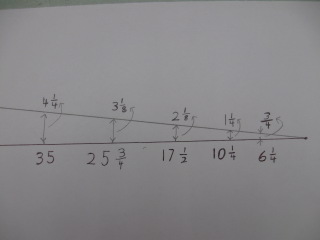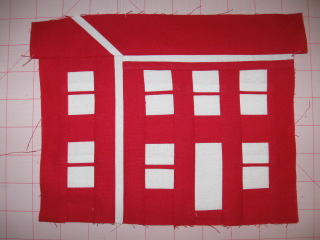MAKING THE WEDGE TEMPLATE
The red and white Vortex quilt has 52 wedge shaped segments. That is a 6.923 deg angle. The template needs to be about 38" long. The exact length will be determined by measuring your strip sets, as explained later. A very large protractor would be needed to make an accurate angle. I found it was better to draw the template from calculations. I picked places that had measurements as close to 1/8" as possible and rounded the numbers. This will be close enough to make a usable template.
The same template is used if you are cutting complete wedges of 21 rows, or if you are cutting the wedges in sections. I will show how this done. But first, the template:
Freezer paper works well (draw on the dull side), but any paper over 40" long and 5" or 6"wide will work.
Draw a 38" straight line, (1/2" or so from the edge) along the length of the paper , starting 1/2" or so from the end. From the end make a mark at these points along the line:
on line of dot (next step)
6 1/4" 3/4"
10 1/4" 1 1/4"
17 1/2" 2 1/8"
25 3/4" 3 1/8"
35" 4 1/4"
Place a square ruler on the line and make a dot directly above the marks on the line the distances given above. (Trigonometry purists will say "This will make a right triangle! We need an isosceles triangle!" These numbers have taken that into account.)
Draw a 38" line thru the set of dots to the end of the line. Some of the dots may be a bit off (the one above the 10 1/4" mark most likely). Keep the line straight, missing the dot if necessary. This should result on a ~6.9 deg angle.
Cut out the template.
Draw a 1/4" sewing line along both long sides of the cut template. These lines are just to use as a reference to check that you are not cutting too deep into the template as you are using it to cut the wedges.
Fold the template in half the long way. Do not worry too much about getting a nice fold on the last 2 or 3 inches of the tip. They will be trimmed away. This fold will be used when marking the template with lines to match up with the seams on the strip sets. It will help keep the seam line marks square with the template.
Place a ruler on the template lining up a line on the ruler with the fold. Slide the ruler to the place where the template is 1/2" wide. This is where the sewing lines should cross, but do not fret if they do not cross exactly there. Cut the tip off the template at this place.
The template is now ready to place on your strip set and mark the seam lines of the strip sets, but first a bit about the cutting and assembly.
This quilt will be made in 4 quadrants. The wedges at the sides of the quadrants will have extra fabric left untrimmed beyond the seam allowances. The quadrants will be pressed well, then trimmed into a right angle. This will insure that they will fit together and lay flat. Most likely the pieces on the outside wedge will end up a bit larger or smaller that the other wedges, but that difference will be hard to detect in the finished quilt. This is true of the quilt I have in the photo, but you would have to measure the pieces to tell. (Any quilt police who want to measure can go find a 9 patch to pick on!)
Each quadrant will have 13 wedges. 2 quadrants will have wedges on the outsides that are white at the top and bottom. The other 2 quadrants will have wedges on the outsides that are red at the top and bottom.
CUTTING WEDGES
IF YOU MADE FULL STRIP SETS (21 ROWS):
Read thru these instructions before you start to cut to have an idea of what you should end up with. You will leave some wedges untrimmed on one side.
Make sure your strip sets are pressed well, seams to the red. Place the template on the strip set with the narrow edge on the edge with the 2" strip (for the center).
Place a square ruler on the template, with a line on the ruler lined up with the fold in the template. Adjust the template so the seams are perpendicular to the fold. Draw a line on the template at each seam and at the outer edge of the strip set.
Each time you cut a wedge, match the lines with the corresponding seam. I found they did not always match as well as I would have liked, but match as closely as possible. Use flat head pins to secure the template, or small bits of double sided tape (or single sided tape formed into a small roll) to help hold the template in place. If you used freezer paper, iron a few small spots to help hold it in place. Use a ruler and rotary cutter to cut out the shape, placing the ruler on the template with the edge along the template edge.
Be careful in picking the wedges up from the mat. The short seams are easy to pull apart.
You will cut 26 wedges with white at the top and bottom. 2 of those wedges will be left untrimmed on the right edge and 2 will be left untrimmed on the left edge. You should be able to cut 7 wedges from a strip set and still have room to leave 2" extra on the left of one wedge and 2" extra on the right of an other wedge. Also cut 7 wedges from the next strip set, leaving the 2" extra on the left of one and 2" extra on the right of one. Cut 8 wedges from the last full strip set, all of them trimmed. The half strip set should give you 4 wedges. That should give you 22 finished wedges, and 2 untrimmed on the left, and 2 untrimmed on the right.
Now cut the strip sets starting and ending in red the same way.
52 total wedges:
22 trimmed starting and ending in red
2 untrimmed on the left starting and ending in red
2 untrimmed on the right starting and ending in red
22 trimmed starting and ending in white
2 untrimmed on the left starting and ending in white
2untrimmed on the right starting and ending in white
IF YOU MADE PARTIAL STRIP SETS:
(Read the instructions above for full strip sets to understand what kinds of wedges you will be making.)
Place the template on the strip set for rows 1 thru 9 with the narrow end at the 2" wide strip. Place a square ruler on the template with a line matching the fold line on the template. Adjust the template and mark the seam lines. Make a mark 1/4" from the outer edge where the sewing line will be when the parts of the wedge are assembled. (You may also draw a line at the outer edge if it helps with placement.)
Cut 26 wedges from the strip set for rows 1 thru 9, starting and ending in white. Leave 1/2" untrimmed to the left on 2 wedges and 1/2" untrimmed to the right on 2 wedges.
Cut 26 wedges from the other strip set for rows 1 thru 9, starting and ending in red. Leave 1/2" untrimmed on the left of 2 wedges and 1/2" untrimmed on the right of 2 wedges. These narrow untrimmed wedges look so much alike it is hard to tell them apart. Mark the untrimmed edge with a pin or sticker to keep track. (This is a place to use up some of those address labels we all get in the mail.)
Here the first 26 have been cut, starting on the next 26. Notice the 4 wedges that are untrimmed on one edge.
Place the template on the strip set for rows 10 thru 17. Place the last seam line you drew for the first strip set 1/4" from the edge where the sewing line will be. Draw the seam lines for this strip set. Mark the last line 1/4" from the other edge where that sewing line will be. (Draw another line on the outer edges if you find it helps to line up the template)
Match these lines with the seams lines as you cut out wedge sections from strip sets beginning in red. Each full strip set should give you 11 wedges, 2 from each strip set untrimmed. (total of 2 untrimmed on the left, 2 untrimmed on the right) Cut 4 more trimmed wedges from the half strip set.
Cut out the wedge sections from the strips sets beginning in white.
Now place the template on the strip set with rows 18 thru 21. Place the last seam line 1/4" from the edge as before. Mark seam lines. Mark the last line on the outer edge.
From the strip sets starting in red, cut 7 wedges, 2 untrimmed, from each of 2 full strip sets. (2 untrimmed on the left, 2 untrimmed on the right). Cut 8 trimmed wedges from the last full strip set and 4 trimmed wedges from the half strip set.
Cut the same wedge sections from the strip sets starting in white.
Sew the sections together into full wedges. Sew untrimmed sections together, lining up the trimmed sides. The untrimmed sides will be jagged, that is OK, that is where we will trim later to get nice square corners for the quadrants.
There should be enough sections to make these wedges:
22 trimmed starting and ending in red
2 untrimmed on the left starting and ending in red
2 untrimmed on the right starting and ending in red
22 trimmed starting and ending in white
2 untrimmed on the left starting and ending in white
2 untrimmed on the right starting and ending in white
























































